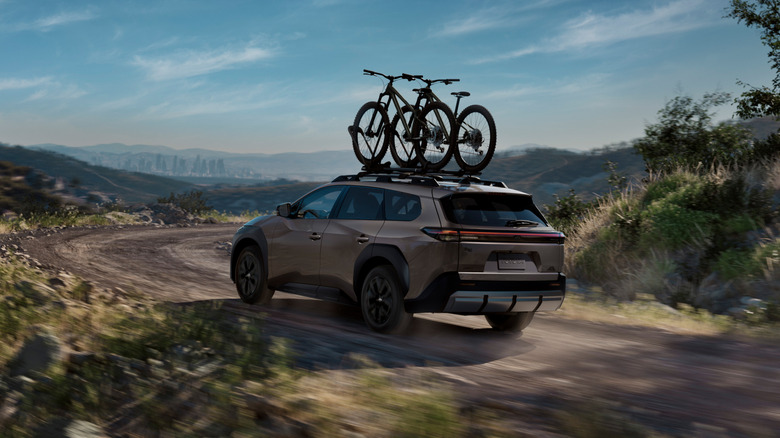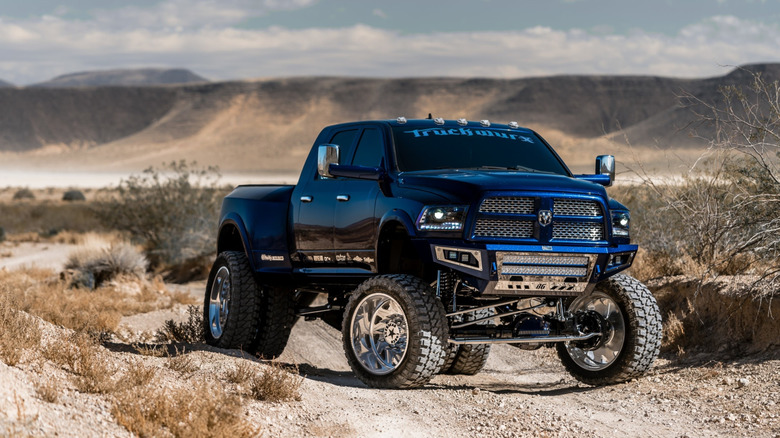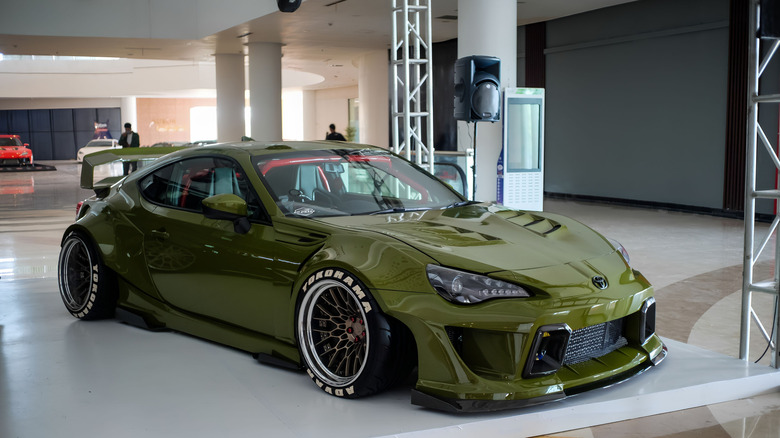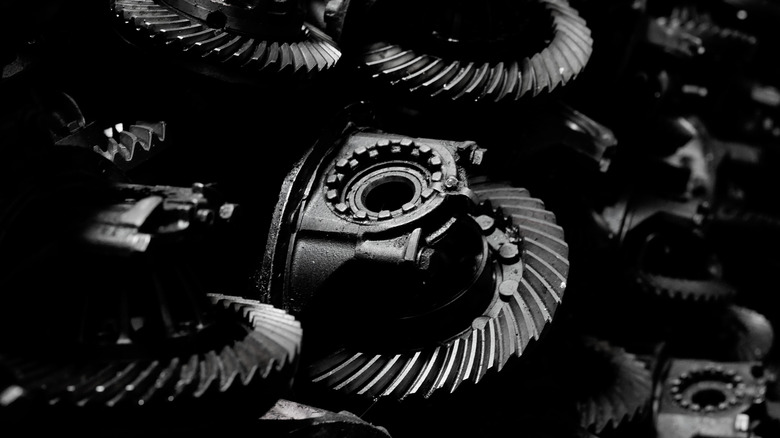5 Car Mods That Will Slow Your Top Speed, According To Drivers
Car modifications have been around since the early days of automotive history. Back in the 1920s, hot rodders did all sorts of things to their vehicles pursuing higher performance. During the 1950s, modded stock cars gave birth to Nascar, and later to custom car culture. People started modding their vehicles not only for speed, but to make them more personalized and unique. Modding has become so popular, that it gave birth to a booming industry which produces high-quality aftermarket parts that improve a car's performance in various ways. Heck, some car modifications even try to fix factory flaws.
However, while they bring improvements in some areas, mods can also make your car worse in others. For instance, lowering your suspension results in better handling, but also a harsher ride. Some popular car mods will even slow your top speed, and often quite significantly. Yes, in most circumstances they offer benefits in other domains, but some are just unnecessary. In this piece, we'll focus exactly on those mods, telling you how and why they make your vehicle slower at the top end. Let's have a closer look!
Aggressive lift kits
Maybe it's because the COVID-19 pandemic reminded us of the value of outdoor spaces, but off-road-ready vehicles have been gaining popularity among buyers since 2020. There's even been a significant uptick in people modifying their SUVs and trucks to make them more off-road capable. Out of all the necessary mods to make your truck off-road capable, lift kits have been the third most popular modification, after tires and wheels. Hardly surprising, as they are cheap and provide significantly higher road clearance for venturing over rough, uneven terrain.
However, lift kits have some significant downsides. Lifting your truck or SUV will create a larger frontal area and mess with the underbody airflow, adding additional aerodynamic drag. This can have a negative effect on speed and gas mileage. On average, you'll add around 0.01 Cd (aerodynamic drag) with every inch gained in ground clearance. How much speed you lose at the top end really depends on the aggressiveness of the lift kit. A small lift of 2-3 inches will result in a slight top speed drop, but bigger lifts (6-8 inches) will markedly reduce the top speed of your truck or SUV.
Lift kits also raise the center of gravity, which negatively impacts on-road handling. Furthermore, they change the suspension geometry, which could result in a less stable highway ride. Expect a harsher ride as well, though that can be mitigated by replacing the stock shocks with more advanced, and costlier, aftermarket solutions.
Bigger wheels with very wide tires
Lift kits usually go hand in hand with larger wheels and tires, because they also open more space inside the wheel well. And if you are serious about going to the most remote places, bigger "flotation" tires are the way to go. They provide higher traction on most terrains, particularly for rock crawling, and can operate at lower pressures for even higher traction gains. Bigger, wider tires look sick, too, which is another big reason why people increasingly choose them for modding their vehicle.
However, bigger tires are also heavier, and plenty of drivers have found they have a negative effect on performance. In isolation, this won't make a huge difference in the top speed, but wider tires also have a larger surface area, resulting in more drag. Combined with the added weight, that can definitely impact your car's top speed. All-terrain tires, which people usually opt for when modifying their truck, also have higher rolling resistance, which further hurts performance.
Car people can also lose top speed by installing huge wheels. Yes, they look sick, but also add rotational mass, which hurts all performance metrics. Worse acceleration. Lower top speed. Longer stopping distances. Less responsive steering and worse handling. Heck, even the ride quality suffers with larger, heavier wheels. Due to all these shortcomings, we strongly advise avoiding cheap aftermarket rims. Instead, choose forged rims, which are lighter and stiffer than the cheaper cast wheels.
Huge Spoilers and Widebody Kits
Spoilers create higher downforce and are an inevitable part of high-performance vehicles. That's because, as you go faster, the spoiler pushes the car down, providing the tires with more grip and enhancing stability. Thanks to this, spoilers allow you to attack corners at even higher velocities, and cut down lap times.
However, spoilers also increase aerodynamic drag. That's true even for factory-installed spoilers, which have been rigorously tested by engineers to provide the best possible balance between straight-line and cornering velocity. Want proof? Let's compare the 911 GT3 and 911 GT3 RS. Both share the same 4.0-liter engine, but the GT3 RS makes more power (519 hp vs. 503 hp). However, due to its more aggressive rear spoiler and overall aero, it only has a top speed of 184 mph. Meanwhile, the 911 GT3 reaches 193 mph! Putting huge rear wings and flaps on your car, particularly underdeveloped aftermarket ones, will significantly hurt your car's top speed.
The same is true for widebody kits. These also have advantages, like allowing you to widen the track and put wider tires for higher grip, in addition to looking sick. But, again, they increase the drag coefficient of your car, which has a negative effect on the top speed. Poorly executed widebody kits can increase aerodynamic drag by up to 30%! If you seek better lap times, stick to well-developed and rigorously tested aftermarket kits to aid your car's cornering performance with a minimal effect on its top speed.
Roof racks, roof boxes, and roof light bars
Don't have enough space for stuff inside your car? A roof rack will give you extra storage in an underused place. You can attach pretty much anything on these racks, from additional cargo to tools, bicycles, kayaks, and even car rooftop tents for camping. Or, you can put on a roof box, which gives you a safer, enclosed space for storing various items. The options are basically limitless.
However, even the most minimal roof additions, like crossbars, can have a significant effect on aerodynamics. Car and Driver tested a Kia Carnival with and without the factory-installed crossbars and measured a 3-mpg better fuel economy with them removed on a 75-mph highway test. Drivers share the same sentiment — crossbars eat into fuel economy. This happens because of the added drag, which also slows down your car's top speed. Putting things on the crossbars will make things worse, as even more drag will be created. This is also true for roof boxes, which also hurt your car's performance, even though they have aerodynamic designs. Drivers also noticed significantly increased wind noise, which affects the long-distance capabilities of your vehicle.
Roof light bars, which have become popular among the off-road crowd, also affect the top speed negatively. According to a paper published by the School of Mechanical and Materials Engineering, University College Dublin, roof-mounted bars on emergency vehicles create an 8-11% increase in drag in square-back vehicles.
Shorter gearing
Internal combustion engines produce usable torque and power in a limited rev range. Thus, if you connect them directly to the wheels, acceleration will be woefully slow, and the top speed very low. For that reason, every ICE car is equipped with a multiple-gear transmission; lower "reduction" gears increase torque for better acceleration, while higher gears multiply the engine's revolutions to increase speed, while enhancing efficiency and comfort.
Every vehicle is also equipped with an additional gear, called the final drive. Like the gears inside the transmission, changing the final drive ratio will have an impact on the car's performance. Longer gearing, like higher gears in the transmission, provides higher top speed, but worsens acceleration. Meanwhile, shorter gearing improves acceleration but slows your top speed.
Shorter gearing is a popular mod among drivers of sports cars, because it makes the car faster off the line. The engine will feel more responsive and eager to build revs, which can be beneficial when driving on the track. However, it will also hamper top speed and keep the engine at higher revolutions on the highway, increasing fuel consumption.
Fun fact: EVs also have a final drive ratio, also called "single-speed transmission." Electric motors provide maximum torque throughout their rev range, so they don't need multi-speed transmissions. So, in theory, you could alter the performance of your EV with a shorter or longer final ratio.
How we chose these mods
For this piece, we started with the writer's expertise in automotive engineering, who studied the matter at the university. Then, we scoured online forums to see whether drivers experienced slower top speeds when installing those mods on their vehicles. Lastly, we double-checked everything using information from other experts in the field, including renowned automotive media and scientific papers.






